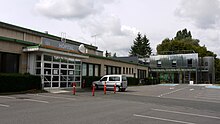Institute Curie
The Institut Curie (formerly Institut du Radium ) is a research center in Paris for biological, biophysical and medical research. The research center run by a foundation is one of the world's leading in the fields of biophysics, cell biology and cancer research. The institute has two hospitals specializing in cancer treatments.
history
The institute was founded as the Institut du Radium in 1911 through the collaboration of Émile Roux , the head of the Institut Pasteur , and the vice- rector of the University of Paris , Louis Liard (1846-1917). The concept consisted of two separate laboratories. One was to research the physics and chemistry of radioactive elements and was under the direction of Marie Curie . The second laboratory had the task of studying the medical uses of radioactivity and was under the direction of Claudius Regaud (1870–1940). The construction work according to the plans of the architect Henri-Paul Nénot (1853-1934) began in 1912 and was completed in 1914. The Musée Curie is now housed in the historic building at 1 rue Pierre et Marie Curie . In 1920 Marie Curie and Claude Regaud founded the Curie Foundation with financial support from Henri de Rothschild . A first small clinic was opened in 1922 on Rue d'Ulm. Here, the Regaud team tested new treatment options that combined surgery and radiotherapy. In 1934 Irène Joliot-Curie and Frédéric Joliot-Curie discovered artificial radioactivity at the Institut du Radium, for which they received the Nobel Prize in Chemistry in 1935 . In 1936 a full hospital was opened. New physics and radiobiology laboratories were inaugurated in Orsay in 1950 under the direction of Irène and Frédéric Joliot-Curie. In 1970 the Curie Foundation and the Institut du Radium merged to form the Institut Curie. Today the institute has numerous research units in cooperation with CNRS and INSERM .
organization
In addition to the research campus on Rue d'ulm, which is part of the Hôpital Claudius Régaud , the Institut Curie now operates another hospital with the René Huguenin Center , and the research center in Orsay has been expanded to become a proton therapy center.
Curie Museum
The Curie Museum was created from her then laboratory shortly after Marie Curie's death. The director's office above the museum was used by her daughter and son-in-law until 1958. After the death of Frédéric Joliot Curie, the office also became part of the museum.
Web links
Individual evidence
- ↑ Susan Quinn: Marie Curie. A biography . Pp. 484-485.
- ↑ Our history. Retrieved February 16, 2019 .
- ↑ Lieux historiques - Musée Curie. Retrieved February 16, 2019 .
Coordinates: 48 ° 50 ′ 36 " N , 2 ° 20 ′ 39" E

